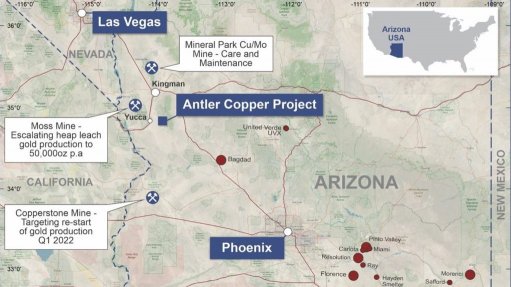Mining companies risk competitive edge without more women on board
TORONTO (miningweekly.com) – Canadian mining companies should have more women on their boards to sharpen their competitive edge, increase diversity and boost creativity, Patrice Merrin told an audience at the Women in Mining Toronto branch last week.
Among her many roles, Merrin was currently a corporate director on the boards of Glencore, Stillwater Mining and Novadaq Technologies. She was also a former president and CEO of Luscar and former executive VP and COO of Sherritt International.
If the industry remained recalcitrant, in Ontario at least, the playing field should be levelled with the introduction of quotas.
“I am in favour of quotas as of 2018, if people do not shape up and increase the percentages in the boardroom. To an extent, I say that out of impatience and exasperation because this is not a supply problem [of notable candidates],” Merrin explained.
Her argument reflected the wider discussion for improved female representation on boards, with many seeking a minimum level of 30%. However, there is debate on how best to achieve this, whether through voluntary programmes or through fixed quotas.
As a comparison, Merrin highlighted how the mining industry lags other sectors, including consumer products and financial services, which currently had between 40% and 45% boardroom representation.
BRINGING OUT THE BEST
Finding and advancing the best and brightest female talent was important because it served the best interests of the company and, through this, the company’s stakeholders. “And management should always work in the interest of the company and its stakeholders,” Merrin noted, adding that she wanted stakeholders to know that "we’re paying attention to get the brightest people with the best ideas and that the DNA of our business is robust and sustainable”.
In tandem with advancing female representation in the boardroom, more needed to be done in building up the pool of available female talent elsewhere in companies.
Women often left the industry early, citing poor managerial motivation and limited opportunities. To mitigate this, companies needed to improve attention to details and be aware of potential latent biases. As an example, Merrin quoted a research study that explored the language used in employment references, which noted a significant drop in the level of pro-active adjectives or stand-out phrases for women compared with men.
Companies also needed to consider the day-to-day workings of their organisation, such as the way meetings were run or how agendas were tabled, with greater thought given to interaction between staff and how to build successful teams. “Pay attention at all levels; we must be more deliberate and take care in a world where talent means a competitive advantage,” she added.
The lack of female presence also deprived a company of heterogeneity and creativity. Without this there was the risk of homogeneity, singularity and blinkered thinking. Diversity also enhanced the odds of positive outcomes, including those that might come as a surprise. As an example, Merrin highlighted that women often proved better at operating heavy equipment on mine sites than men.
More creativity was also needed in fostering expertise and allowing both men and women to find opportunities outside their initial comfort zones. Allowing for the cross-pollination of talent could also involve hiring people with different backgrounds such as liberal arts graduates.
Dovetailing into this, improved on-the-job training and work experience should be considered for all members of staff. “Change up the Rubik’s cube of who does what and who gets exposure to things. For instance, I don’t know why we don’t do more trailing, so let someone trail a comptroller or an [information technology] IT person. And why not have an IT person down at the coal face?” she asked.
PART OF THE UPSIDE
In terms of personnel development, Merrin stressed that the world was inherently unfair and that individuals needed to adapt. However, a person could improve their opportunities and working lives by staying motivated and by being their own best advocate.
“And if you’re a person who feels they’re not being noticed or recognised, then you should figure out how to have difficult conversations and be articulate in doing so,” she added. “Tell your own narrative.”
People should also avoid thinking about their careers in a linear manner, whereby they try to move from A to B with a set formula in mind. Instead, Merrin stressed the importance of seizing random opportunities and “free ranging” in a career.
“Be open to randomness because, in mining, women are still part of the surprise – we are part of the upside and we are everything this business needs: renewal, heterogeneity, robustness, randomness, better imagination and better thinking,” she enthused.
Comments
Announcements
What's On
Subscribe to improve your user experience...
Option 1 (equivalent of R125 a month):
Receive a weekly copy of Creamer Media's Engineering News & Mining Weekly magazine
(print copy for those in South Africa and e-magazine for those outside of South Africa)
Receive daily email newsletters
Access to full search results
Access archive of magazine back copies
Access to Projects in Progress
Access to ONE Research Report of your choice in PDF format
Option 2 (equivalent of R375 a month):
All benefits from Option 1
PLUS
Access to Creamer Media's Research Channel Africa for ALL Research Reports, in PDF format, on various industrial and mining sectors
including Electricity; Water; Energy Transition; Hydrogen; Roads, Rail and Ports; Coal; Gold; Platinum; Battery Metals; etc.
Already a subscriber?
Forgotten your password?
Receive weekly copy of Creamer Media's Engineering News & Mining Weekly magazine (print copy for those in South Africa and e-magazine for those outside of South Africa)
➕
Recieve daily email newsletters
➕
Access to full search results
➕
Access archive of magazine back copies
➕
Access to Projects in Progress
➕
Access to ONE Research Report of your choice in PDF format
RESEARCH CHANNEL AFRICA
R4500 (equivalent of R375 a month)
SUBSCRIBEAll benefits from Option 1
➕
Access to Creamer Media's Research Channel Africa for ALL Research Reports on various industrial and mining sectors, in PDF format, including on:
Electricity
➕
Water
➕
Energy Transition
➕
Hydrogen
➕
Roads, Rail and Ports
➕
Coal
➕
Gold
➕
Platinum
➕
Battery Metals
➕
etc.
Receive all benefits from Option 1 or Option 2 delivered to numerous people at your company
➕
Multiple User names and Passwords for simultaneous log-ins
➕
Intranet integration access to all in your organisation





















